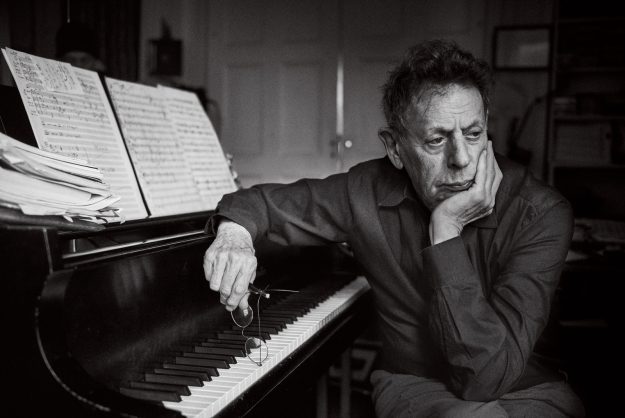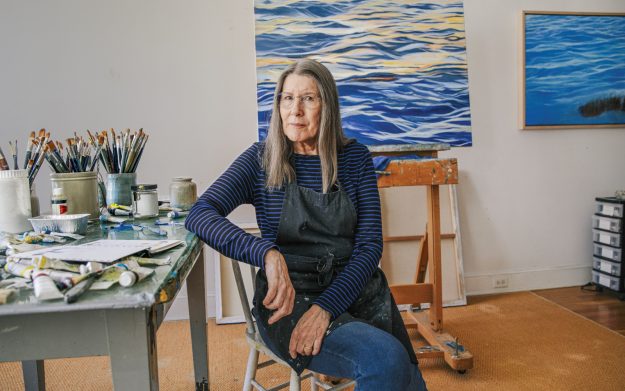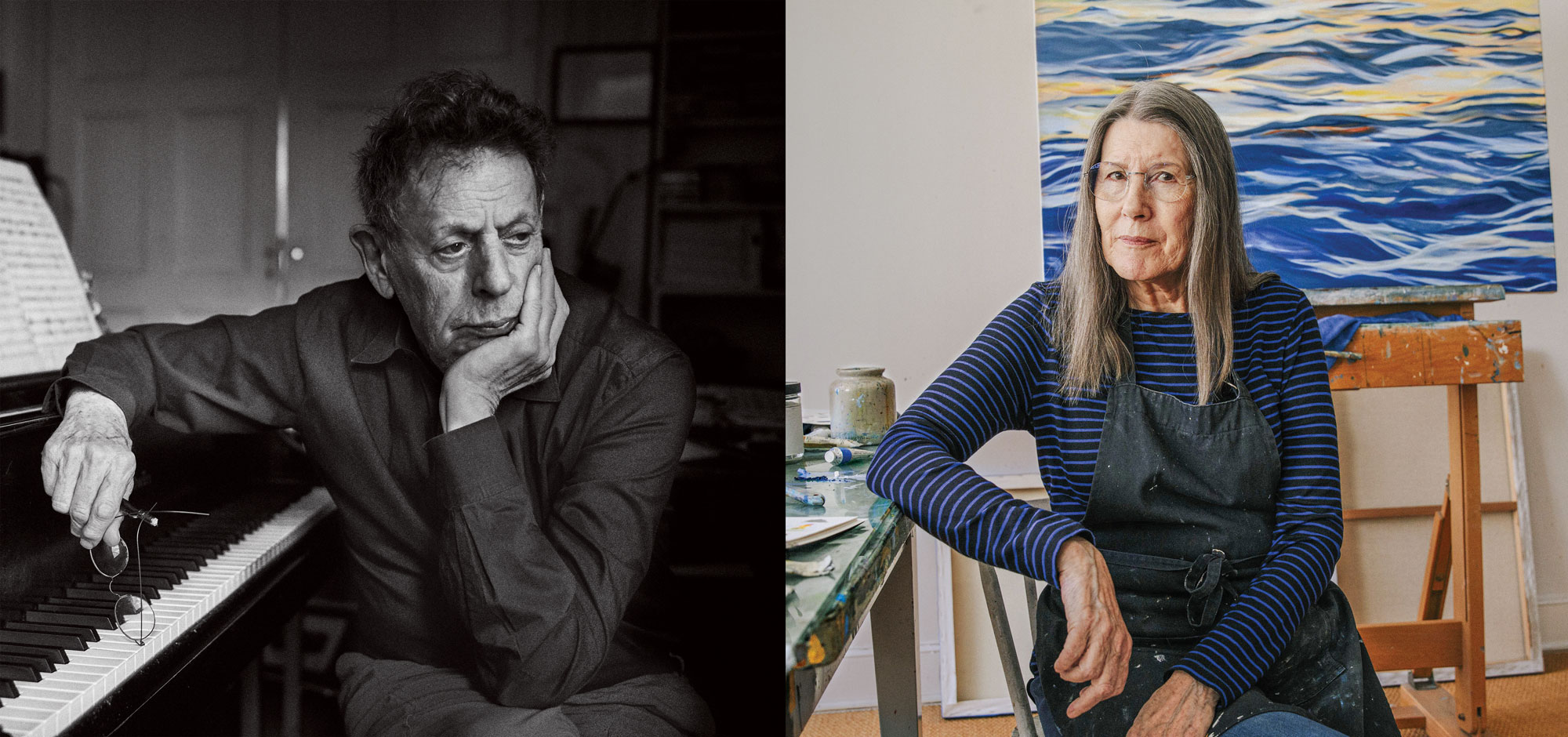We are on the phone, freewheeling about our practices: music, art, and meditation. Another day, we are in Philip’s kitchen, sitting at a wooden table. Behind us are comfortable couches and a private outdoor space. Philip’s partner, the artist Saori Tsukada, is working with flowers in the urban garden surrounding the house.
—Fredericka Foster
Philip Glass (PG): I was talking once to Gelek Rimpoche [1938–2017] about meditation, and I asked him, “Isn’t it just paying attention?” Yes, he said, “that’s absolutely what it is.” Meditation is a nice fuzzy word that we all like to talk about—but paying attention is placing your mind and functioning in a different way.
During the few years I have practiced meditation, I have worked with a number of texts. Say I am reading texts I have read many times—I’m thinking of the first Panchen Lama’s book on guru devotion [Lama Chöpa: The Guru Puja], which is not well understood. It is not about the guru; it is about the devotion. When I decide to really pay attention, I go back in my memory and look at some of the initiations I have taken. I watch the language change from awareness to remembering. It is possible to train the mind to increase memory.
I once asked the [scholar-teacher] Demo Rinpoche how many books he had memorized, and he replied that he wasn’t doing much memorizing at all—he thought only about 19! I’m sure it is many more now, and Gelek Rimpoche had memorized a library. The Tibetan culture cultivated the idea of memorizing. The passing on of wisdom could have been very accurate, since this was their main way of sharing information. The Tibetan lamas would memorize entire books and then, looking at a particular page, include the footnotes from other books they had read to verify a particular idea or lineage in the book they were writing themselves.

Fredericka Foster (FF): And here I am, still working to memorize all the texts that I work with daily! Memorization is also a part of a visual artist’s training. When we learn to draw, we work from reality—say, at its simplest, a still life. First we draw a series of lines to establish a compositional placement on the page. Then we memorize a line, draw it, and go back to the source to check it. We keep doing that until we have trained our hand to accurately follow our eye. Another memory exercise involved going through a pile of one thousand prints in a day and then discussing what we had seen. Or we would spend hours in front of a single painting and then sketch it out later.
PG: Culture has often been passed from one generation to the other through the power of memorization. We know the Bible was written 200 years after the birth of Christianity, so we assume it was made up. But it is possible that a sharp mind could remember very clearly and pass it along to another sharp mind, so the passing along of wisdom could have actually been very accurate, maybe more accurate than you would find in books, which are subject to typographical error, bad editions, and missing pages.

FF: Tibetan Buddhism attracts a lot of visual artists, and I suspect it is because we take easily to the many visualization exercises available for practitioners. I remember your telling me that your father taught you to play mental chess, which would certainly serve to sharpen your memory.
PG: Yes, he began doing that with his brother to pass time while they were waiting for the papers to be delivered for their paper route. And he continued playing with me and my brother.
If you go back to the 15th and 16th centuries, people didn’t write down everything. Many people didn’t write at all! One memorizing trick was to visualize a bookshelf and to actually visualize the names of the books on the shelf. I tried this once to see if it would work with a dance company in Australia. There were 20 people in the company, and we worked with them for a few days. With each member, I visualized their name on a book cover and put it in a certain location on an imaginary shelf. The last day I was able to say goodbye to each one, correctly remembering their names while looking at the bookshelf I had created in my mind. And they said, “How did you do that?” Well, what I was doing was trying to see if that thing worked. It did work.
“When that intensity of attention is applied to creating, you can’t stand outside and watch it; you have to give up the witness.”
FF: And we both did a lot of memorization in school—of poetry, speeches, and so on. It’s helpful when we memorize sutras and prayers today.
PG: All that also serves to assist us with the flow of attention. I once heard someone say he didn’t understand meditation. I said, “Forget that word; just pay attention to what you are doing.” We had been talking about infinity, and my friend suggested it was the flow of eternity, and I said that is the whole idea, the process of the mind attending to what you are doing, one moment at a time.
I find that when that intensity of attention is applied to creating, you can’t stand outside and watch it; you have to give up the witness. People ask me all the time, “Where did that music come from?” I have no idea, because all my energy went into writing the music. Since I had no awareness of myself writing, I had extra energy to increase the depth of concentration. It left me without the awareness of doing the work. I discovered that being aware of myself creating was an indulgence I couldn’t afford.
FF. It sounds like you have somehow overcome dualism when you are writing music. It’s like the state we work to achieve in order to become one with the object of meditation.
PG: Actually, when I decided to explore where music lived, I found that music comes from dreaming. I noticed I would wake up with a piece of music very clear in my mind. I thought these were stray ideas, but then I became curious where these ideas came from—the dreaming function of the mind is not ordinarily available to us. So I decided to wake up and write it down.
Recently, I was considering working on King Lear, a play I don’t like very much, and I was thinking I don’t want to write music for this. I finished the play and went to sleep. Then, at 5:30 in the morning, I heard music playing, and realized it was King Lear music and that the play was all about Lear’s relationship with his daughter; everything else was distraction. I went to the piano without hesitation. I started to write words by hand to describe the idea, then I sketched the music—a few measures. I thought it was the beginning of Lear, but actually it was the end.

FF: I keep pen and paper at my bedside and write or draw ideas as they appear. I haven’t done much with these ideas, but you are inspiring me to pay closer attention to them.
PG: Dreaming is the most personal and unique function that we don’t normally share with others. In analysis, we paid a lot of attention to dreams, but I am not talking about Freudian analysis and projecting it onto everyone else. What I learned from analysis was to give up my interest in the uninteresting—all those family issues made me bored with myself, and I didn’t have to do that anymore. Maybe the analyst knows this is what is happening. I read that during the first two hours of sleep, the mind looks at the day just past and sorts out memories to be preserved and those to be put away. The mind acts as an archivist. The creative part comes close to morning, before you wake up. When I wake up, I ask myself What was I just thinking? It is probably what I was dreaming about.
FF: Are you talking about lucid dreaming?
PG: No, but I can stand at the door of my dream and look into the room, as it were. It’s not complete, but it’s enough. Before I write, I access that dreaming state. I may never understand the dream, but what is important is that the material of the dream has become available.
FF: You encouraged me once to see the Cocteau Orphic trilogy, which inspired you to write an opera triptych. Those three films explore dreams and myths and can be watched again and again. When I moved from doing paintings exploring the symbols of faith and myth to working with images of water, I felt that I moved into metaphor and closer to the dream state. I am so relaxed looking at water. It frees my mind to wander, and I get new ideas, or watch old ones come together.
PG: The challenge of any artist is to keep the fire of creativity alive. What we mostly do is, we get good at doing something, and we keep doing it and don’t change much at all. If I look at the work of Sol LeWitt [1928- 2007], it is extraordinary, but it doesn’t change much. [Josef] Albers did manage to work with a square in a square over and over, but while they might look the same, they are not the same at all because of the influence of color.
An artist like me wants radical change. I found that the engine of change was working with new people and the new ideas they brought to the conversation. It didn’t turn into a formula, but I often did this.
Bob Wilson and I did [the opera] Einstein on the Beach, and it was very successful. To avoid doing “The Son of Einstein on the Beach,” I next did the opera Satyagraha, which was completely different. That was counterintuitive. We all want to please people. Your gallery wants you to make more of the same kind of paintings because they were successful. Most people follow success with another similar one, but I wanted to keep creative thinking alive in the process.
Every time I made a big change, I would lose a lot of people, but I would get some new ones. I found 50 percent of people liked it and 50 percent didn’t.
FF: After the Fischbach Gallery [where I regularly showed] left New York and went online, I found my work changing. I’ve always had to solve a new problem with each painting, but now I feel free to change what I was doing in a more radical way.

PG: I’ve noticed your work is changing. I have turned this change idea into a mantra: I am never happier than when I don’t know what I am doing. Still, I have moments of panic. How is this going to work? It can be very stressful trying to do new things, and I am not always completely successful, but I change as much as I can.
I discovered it was impossible not to do something familiar to some degree. When working in theater, I had to have at least one person who would come with me into a new project. I had to find a compromise about what I was willing to know and not know. I found I had to take something with me. Parts of my language would have to be the same, or my task would become impossible.
FF: In your ninth symphony, I feel like you are communing with the cosmos; there seems to be a seamless interaction between art and meditative revelation.
“I have turned this change idea into a mantra: I am never happier than when I don’t know what I am doing. Still, I have moments of panic.”
PG: Our minds are working all the time, but we can’t drive thoughts into awareness. As an artist, you are distilling your thoughts all the time, or listening to music, or paying attention to images. You are probably painting very differently now than you did when you were young, and some of that will be due to the fact that you have learned how to master your attention.
Once when I was in the mountains of Mexico with friends, we had to cross a valley to where we left our car. It looked to me like we didn’t have time to get there. If it got dark and we were in the desert, we would be in trouble. We started walking in a focused-intention kind of way—they called it a walk of attention. A walk that would have normally taken 40 minutes took 10. I had that experience of being able to pay attention to my attention, to actually cross a valley in a much shorter period of time so that we got to where we needed to in the light. We’re talking about pretty hardcore reality. The only way to do it was to command my attention to the point where I was able to make that happen. You can say “Well, you just made that up.” Of course I just made it up; how else could it have happened if I hadn’t made it up? But the fact of the matter is, I got across the valley before the sun went down. I know you’ve experienced something like that in painting.
FF: Yes, and at those times it seems that the painting paints itself. Later, I think, How did I do that? I’ve also experienced the sensation of entering the consciousness of animals, or even fish, when I have been watching water; suddenly feeling the sense of hunger and of being prey at the same moment—imagination becoming compassion. Music, art, and meditation are all means of accomplishing deep mental targeting of our feelings of interdependence and compassion.
PG: Bravo!
Thank you for subscribing to Tricycle! As a nonprofit, we depend on readers like you to keep Buddhist teachings and practices widely available.
